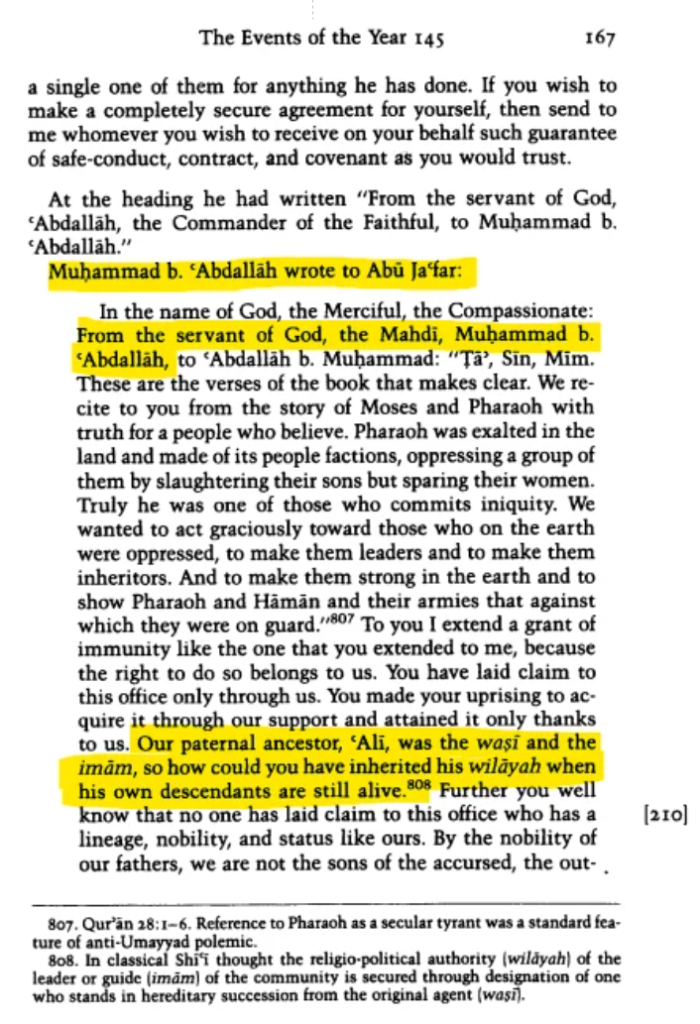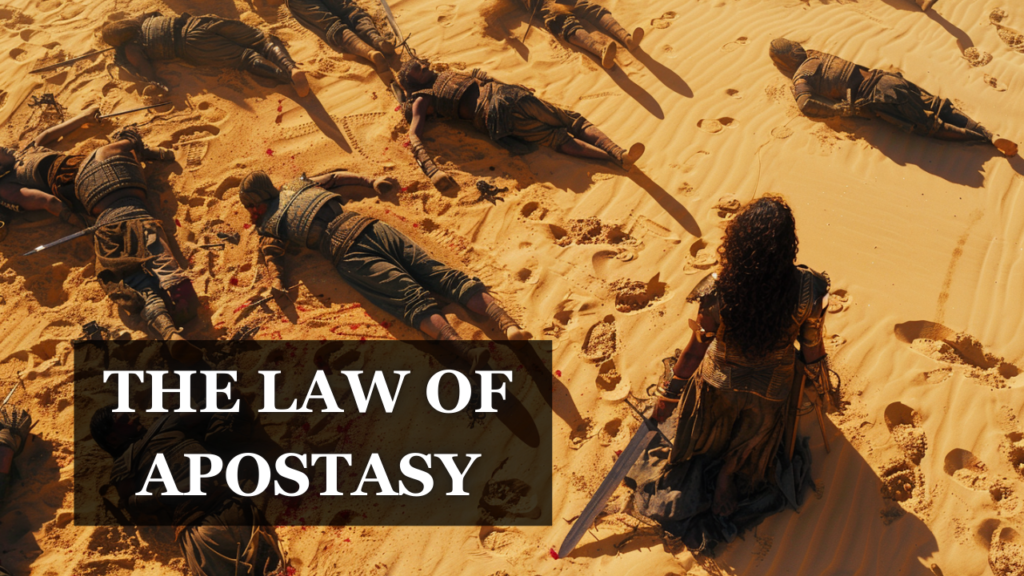Hadith in Question
“If there were no more time left in this world except for a night, Allah would prolong that night until a man from my house whose name matches my name and whose father’s name matches my father’s name reigns and fills it with justice and righteousness as it was filled with injustice and oppression.”Isnad: Abdullah ibn Masud – Zirr ibn Hubaish – Asim ibn Abi Najd – Amr b. Abu Qais – Harun ibn al Mughira – Hamid ibn Muhammad – Husayn ibn Ishaq
(Reported by Al-Tabarani: 10224)
When we look the hadith in question, we see three details about this prophesied Mahdi figure.
- “a man from my house” – this mahdi will come from the lineage of Prophet Muhammad
- “whose name matches my name” – this mahdi will have the same name as the Prophet: Muhammad.
- “and whose father’s name matches my father’s name” – the father’s name of the mahdi will be the same as Muhammad’s father’s name: Abdullah.
So from this we can gather that the Mahdi, a descendant of the Prophet Muhammad, will have the same name as him: Muhammad ibn Abdullah. There are many repeat-variants of this hadith. When we diagram this hadith t0 examine the transmission history, we see exactly where this hadith proliferated:

When analyzing the transmission of this hadith, it becomes evident that ʿĀṣim ibn Abū al-Najūd is the central figure responsible for its proliferation. Across the various chains of transmission, we find 10 distinct transmitters who all claim to have received this tradition directly from ʿĀṣim, preserved through 13 different transmission routes. This consistent attribution firmly establishes that ʿĀṣim is the earliest verifiable link in the chain, making it impossible to trace the hadith beyond him with certainty. In other words, the earliest this tradition can reliably be dated is to ʿĀṣim himself.
While ʿĀṣim attributes the hadith to Zir ibn Hubaysh, who allegedly received it from Abdullah ibn Masʿūd, there is no corroborative evidence to support this claim. Zir, a well-known transmitter, does not have any parallel or independent chains reporting this specific tradition, which raises serious doubts about the link between him and ʿĀṣim. Moreover, the absence of any corroborating transmission from other students of Zir further weakens the claim. Without independent validation, the connection between ʿĀṣim and Zir—and by extension, the link to Ibn Masʿūd—remains unsubstantiated and merely based on faith.
This lack of corroboration is particularly problematic for a hadith of such theological and eschatological significance. In hadith criticism, traditions that rest on singular claims, especially when they arise in politically charged contexts, are inherently weaker and more susceptible to fabrication. In this case, the singular reliance on ʿĀṣim as the source for such a pivotal tradition undermines its credibility. Consequently, the evidence strongly suggests that this hadith originates with ʿĀṣim himself and was not authentically transmitted from Zir ibn Hubaysh or Abdullah ibn Masʿūd. It would be best to investigate ʿĀṣim in the books of ilm al rijal to know who exactly we’re dealing with.
ʿĀṣim ibn Abū al-Najūd
وقال عبد الله بن أحمد، عن أبيه: كان رجلا صالحا قارئا للقرآن، وأهل الكوفة يختارون قراءته، وأنا أختارها، وكان خيرا ثقة، والأعمش أحفظ منه، وكان شعبة يختار الأعمش عليه في تثبيت الحديث. وقال أيضا: عاصم صاحب قرآن، وحماد صاحب فقه، وعاصم أحب إلينا [تهذيب التهذيب (2/ 250)]]
Translation:
ʿAbdullah ibn Ahmad reported from his father (Ahmad ibn Hanbal):
“He (ʿĀṣim) was a righteous man and a reciter of the Qur’an. The people of Kufa preferred his recitation, and I also prefer it. He was virtuous and trustworthy, though Al-Aʿmash had better retention than him. Shuʿbah preferred Al-Aʿmash over him in confirming (the authenticity of) hadith.“He also said:
(Tahdhīb al-Tahdhīb, 2/250)
“ʿĀṣim was a master of the Qur’an, and Ḥammād was a master of jurisprudence (fiqh), but ʿĀṣim is more beloved to us.”
وقال يعقوب بن سفيان: في حديثه اضطراب، وهو ثقة [تهذيب الكمال (13/ 473)]
Translation:
Yaʿqūb ibn Sufyān said:
(Tahdhīb al-Kamāl, 13/473)
“There is inconsistency in his hadith, yet he is trustworthy.”
وقال ابن سعد: أنبا عفان، ثنا حماد، ثنا عاصم قال: ما قدمت على أبي وائل من سفر قط إلا قبل يدي. قالوا: وكان عاصم ثقة إلا أنه كان كثير الخطأ في حديثه. [إكمال تهذيب الكمال (7/ 100)]
قال ابن سعد: كان ثقة، إلا أنه كان كثير الخطأ في حديثه [تهذيب التهذيب (2/ 250)]Translation
Ibn Saʿd said:
ʿAffān narrated to us, saying: Ḥammād narrated to us, saying: ʿĀṣim said, “Whenever I returned from a journey, Abū Wāʾil would kiss my hand.”They said: “ʿĀṣim was trustworthy, except that he made many mistakes in his hadith.“
Ibn Saʿd also said:
(Ikmāl Tahdhīb al-Kamāl, 7/100), (Tahdhīb al-Tahdhīb, 2/250)
“He was trustworthy, except that he made many mistakes in his hadith.”
ʿĀṣim ibn Abū al-Najūd (عاصم بن أبي النجود) was a prominent Qur’anic reciter, born around 700 CE in Kufa, Iraq. He was one of the most influential figures in the transmission of the Qur’anic recitation and is renowned for his role as one of the seven main reciters of the Qur’an. ʿĀṣim was a student of famous scholars such as Zir ibn Hubaysh and Al-Aʿmash, who were key figures in preserving the Qur’anic tradition. He is best known for his precise and clear style of reciting the Qur’an, which became highly regarded in Kufa, a major center for Islamic scholarship.
While ʿĀṣim’s contributions to hadith transmission were also significant, he was known to have made occasional errors in his narrations. Ibn Saʿd, a prominent scholar of hadith, noted that ʿĀṣim was “trustworthy,” but also “made many mistakes in his hadith.” This view is reflected in works such as Ikmāl Tahdhīb al-Kamāl (7/100) and Tahdhīb al-Tahdhīb (2/250). Despite these occasional errors in hadith transmission, ʿĀṣim’s recitation of the Qur’an was widely respected for its accuracy and precision, and his role as a teacher was paramount in preserving the Qur’anic tradition.
One of ʿĀṣim’s most notable students was Hafs ibn Sulaiman, who became the most famous transmitter of ʿĀṣim’s recitation style. Hafs’ transmission of ʿĀṣim’s recitation, known as Hafs an-ʿĀṣim, has become the most widely recited version of the Qur’an today. As a result, the Hafs an-ʿĀṣim rendition is the dominant Qur’anic recitation used in the Muslim world and is the version found in nearly all printed copies of the Qur’an.
Muhammad ibn Abdullah ibn … ibn … ? (al-Mahdi)

The hadith in question, which speaks of a figure from the Prophet Muhammad’s family who would rise to fill the world with justice, can reliably be traced back to ʿĀṣim ibn Abū al-Najūd, but no further. This is because, as established in hadith criticism, ʿĀṣim is the earliest verifiable figure in the transmission chain. Various narrations of this hadith consistently cite ʿĀṣim as the primary link, with 10 different transmitters claiming to have received it from him across 13 different transmission routes (Ikmāl Tahdhīb al-Kamāl, 7/100). Furthermore, while ʿĀṣim attributes the hadith to Zir ibn Hubaysh, who allegedly received it from Abdullah ibn Masʿūd, there is no corroborative evidence from other independent chains to confirm this transmission. As a result, while we can be confident in the authenticity of ʿĀṣim’s transmission, there is insufficient evidence to trace this hadith back beyond him.
However, when we look more closely at the recorded lineage of the Prophet Muhammad, one figure emerges who perfectly fits the criteria described in the hadith: Muhammad ibn Abdullah al-Nafs al-Zakiyya. Muhammad al-Nafs al-Zakiyya, the grandson of Hasan ibn Ali, claimed to be the Mahdi during his uprising against the Abbasid Caliphate in 762 CE. His name, Muhammad ibn Abdullah, directly aligns with the description in the hadith of a figure whose name matches that of the Prophet Muhammad, and whose father’s name matches that of the Prophet’s father, Abdullah.

(trans. by Jane Dammen McAuliffe)
This is no coincidence. The timing of Muhammad al-Nafs al-Zakiyya’s rebellion against the Abbasids coincides closely with the period during which ʿĀṣim ibn Abū al-Najūd was active in transmitting hadiths. ʿĀṣim, living in Kufa during a period of intense political unrest, would have been highly aware of the growing discontent with the Abbasid regime and the claims made by figures like Muhammad al-Nafs al-Zakiyya. As a prominent reciter and transmitter of hadith, ʿĀṣim likely heard of Muhammad al-Nafs al-Zakiyya’s self-proclaimed Mahdist role, and it’s conceivable that the hadith could have been either influenced by or retroactively crafted to align with his figure.
The political climate at the time further strengthens this argument. The Abbasid Caliphate, which had initially come to power promising justice and fairness, was increasingly seen as corrupt and tyrannical. Muhammad al-Nafs al-Zakiyya, as a descendant of the Prophet, presented himself as a righteous alternative to the Abbasid rulers, attracting significant support in regions like Kufa and the Hejaz. The idea of a Mahdi, a divinely guided figure who would restore justice, resonated deeply with the masses during this time.
Given the historical context, it is plausible that the hadith was either fabricated or adapted to fit Muhammad al-Nafs al-Zakiyya’s rise. His claim to be the Mahdi, combined with the perfect match between his name and the description in the hadith, suggests that this hadith was strategically used to legitimize his movement and rally support for his revolt against the Abbasid Caliphate.
The Fate of Muhammad al-Nafs al-Zakiyya
Muhammad al-Nafs al-Zakiyya, the grandson of Hasan ibn Ali, rose to prominence in 762 CE when he led a major revolt against the Abbasid Caliphate, claiming to be the Mahdi—a divinely appointed savior destined to restore justice to a world filled with oppression. His claim resonated with a large faction of the population, particularly those who were disillusioned with the Abbasid rulers, who had become increasingly corrupt and tyrannical after seizing power under the banner of justice and fairness. Muhammad al-Nafs al-Zakiyya’s rebellion gained significant support, especially in the regions of Kufa and the Hejaz. His name, Muhammad ibn Abdullah, perfectly matched the description found in the hadith about the Mahdi, leading many to believe in his cause.
However, despite the fervent support he garnered, Muhammad al-Nafs al-Zakiyya ultimately failed in his attempt to overthrow the Abbasids. His rebellion was crushed, and he was killed in 762 CE, leaving his movement to collapse. The Abbasid Caliphate managed to maintain its hold on power, and Muhammad al-Nafs al-Zakiyya’s aspirations to be the Mahdi were dashed. His defeat, however, did not erase the deep yearning for a just ruler that had fueled his uprising. The belief in the Mahdi as a divinely guided figure who would restore justice and righteousness continued to resonate deeply with the Muslim masses.
Despite Muhammad al-Nafs al-Zakiyya’s failure, the hadith that spoke of a Mahdi whose name would be Muhammad ibn Abdullah continued to persist and thrive. Over the centuries, this hadith was canonized in numerous hadith collections, becoming firmly embedded in the Islamic tradition. The preservation of this hadith in collections like Tabarani, Ibn Hibban, Abu Dawud, and others ensured its widespread circulation and perpetuated the belief in the coming of a Mahdi who would fulfill the prophecy, even after the historical figure of Muhammad al-Nafs al-Zakiyya failed in his own claim.
Today, this hadith continues to shape the expectations of many Muslims regarding the future. The belief that the Mahdi will arise to restore justice and righteousness is deeply entrenched in the collective memory of the Muslim masses. Many believe that the Mahdi’s name will be Muhammad ibn Abdullah, in direct alignment with the prophecy in the hadith. This belief, despite the historical failure of Muhammad al-Nafs al-Zakiyya, lives on, with some viewing the prophecy as an indication that the Mahdi’s arrival is yet to come.
Transcript of 0:25-
“…Prove it. First of all, the Prophet told us: he would be called Muhammad, like the Prophet’s name. And his father’s name is like the Prophet’s name, Abdullah. So the Mahdi must be Muhammad ibn Abdullah. This is his name.“
0:26 – 0:43
“…and the Mahdi cannot be killed like that until he rules the world. And for ten years, he fills it with justice, and his name is Muhammad, son of Abdullah. Just like the Prophet Muhammad, son of Abdullah, his father. He will have the same characteristics as the Prophet Muhammad. Same character, very similar manners and character.”
4:20 – 4:43
The ongoing existence of this hadith, preserved in the Islamic tradition and constantly reinforced by its repeated mention in various hadith compilations, has created an enduring conviction in the hearts of the Muslim masses. The anticipation of the Mahdi’s coming is now regarded as a cornerstone of eschatological belief in Sunni Islam. The notion that a figure will emerge who will bear the name Muhammad ibn Abdullah and fulfill the mission of establishing justice across the world is simply the creation of ‘Asim (or Kufans around him, inherited by ‘Asim) in order to propagate the historical Muhammad al-Nafs al-Zakiyya during his lifetime.
[6:112] We have permitted the enemies of every prophet—human and jinn devils—to inspire in each other fancy words, in order to deceive. Had your Lord willed, they would not have done it. You shall disregard them and their fabrications.
[6:113] This is to let the minds of those who do not believe in the Hereafter listen to such fabrications, and accept them, and thus expose their real convictions.
[6:114] Shall I seek other than GOD as a source of law, when He has revealed to you this book fully detailed? Those who received the scripture recognize that it has been revealed from your Lord, truthfully. You shall not harbor any doubt.
[6:115] The word of your Lord is complete, in truth and justice. Nothing shall abrogate His words. He is the Hearer, the Omniscient.
[6:116] If you obey the majority of people on earth, they will divert you from the path of GOD. They follow only conjecture; they only guess.
Addendum: Further Clarifications
In response to inquiry, it is important to refine the argument and address concerns regarding the plausibility of fabrication and Asim’s potential motives. A key distinction raised was the difference between proving the possibility of fabrication and establishing its plausibility. This argument rests on several interconnected factors. First, the geographic and political context: Asim was based in Kufa, a city known for its strong pro-Ahlul Bayt leanings and consistent opposition to Abbasid rule. During this time, Kufa was a hub of political and religious tension, often producing and transmitting narratives that supported figures tied to the Prophet’s lineage. The city’s environment, combined with the political dynamics of the Abbasid era, makes it plausible that narrators in Kufa would fabricate or propagate hadith to support figures like Muhammad ibn Abdullah, whose ties to the Ahlul Bayt resonated deeply with Kufan sentiments.
Second, the chronological alignment of the hadith strengthens the case for its fabrication. The hadith in question emerged after 145 AH, coinciding with Muhammad ibn Abdullah’s rebellion against the Abbasids. Notably, earlier hadith about the Mahdi exist but lack the specific details found in this narration. This absence suggests that the details aligning the Mahdi with Muhammad ibn Abdullah’s identity—his name, lineage, and father’s name—were likely added during or after the rebellion. If the hadith were genuine, one would expect it to appear in earlier records unconnected to the political events of the mid-2nd century AH. This timeline, combined with the precision of the hadith’s content, further supports the argument that it was crafted or popularized to legitimize Muhammad ibn Abdullah’s claim as the Mahdi.
Another criticism raised concerns about the lack of direct evidence proving Asim’s motives, such as explicit statements showing bias toward the Ahlul Bayt or animosity toward the Abbasids. While direct evidence is indeed absent, the circumstantial evidence remains compelling. Asim’s environment in Kufa, a city historically supportive of the Ahlul Bayt, strongly suggests that he or those in his circle were sympathetic to their cause. This is not an unfounded assumption but a deduction based on Kufa’s well-documented history of producing movements and narratives opposing both Umayyad and Abbasid rule. While it is theoretically possible that Asim was neutral or sympathetic to the Abbasids, the political and cultural dynamics of his setting make this far less likely. The argument is not one of certainty but of probability, given the historical patterns of hadith fabrication for political and theological purposes during this era.
Finally, the critique of citing Asim’s inconsistency in hadith transmission deserves further exploration. It was noted that modern critics, particularly those outside the traditional hadith framework, may not view classical hadith scholars as authoritative. This is a valid observation, but the citation of Ibn Sa’d and others serves an important purpose: even within the framework of traditional scholarship, Asim’s reliability in transmitting hadith was questioned. Scholars like Ibn Sa’d and Yaqub ibn Sufyan acknowledged his Qur’anic expertise but noted his inconsistencies in hadith, which undermines his reliability for narrations of theological and eschatological significance. While this critique may not resonate with everyone, it highlights that skepticism toward this hadith’s authenticity is not unique to a modern, non-traditionalist lens.
In summary, the argument for fabrication rests on the convergence of political, geographical, and historical factors, as well as narrational patterns from the era. The emergence of this specific hadith after 145 AH, its Kufan origins, and its alignment with Muhammad ibn Abdullah’s identity suggest a deliberate attempt to use religious narratives for political purposes. While absolute certainty is unattainable without explicit evidence, the balance of probabilities strongly favors the view that this hadith was fabricated or popularized to support Muhammad ibn Abdullah’s rebellion. These clarifications address the criticisms raised and provide a more comprehensive foundation for the argument.


Pingback: Exposing the False Use of 'Ummiyeen' in Hadith - hadithcriticblog.com
Pingback: The Abbasid Mahdi - The Black Banners & Abu Al-Saffah - hadithcriticblog.com
Pingback: Fallible Transmitters Transmitting Infallible Text (The Quran) - HadithCritic